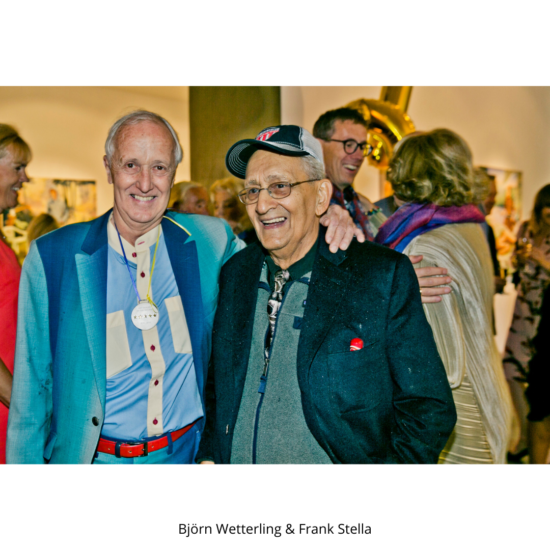
NEW ARRIVALS:
WETTERLING, STOCKHOLM
May 10th 2021

PART I
JSVCprojects is delighted to announce our new collaboration with Gallery Wetterling; I first met Björn Wetterling in March of 1990 at the Tokyo Art Fair. It is worth sharing here this story I told at the 40th anniversary dinner for Björn in Stockholm in 2018. I had left John Gibson Gallery after a decade and wanted to learn about the business of Modern Masters from a New York dealer with a great eye, Barbara Mathes. She was also one of the few women dealers on Madison Avenue trading with the great and the good. I wanted to learn from the best, and she was and remains so. We arrived in Tokyo at the top of the market with a very elegant installation of Matisse, Picasso, Cézanne, Futurist, Constructivist works on paper. A very impressive collection of works installed artfully in a convention complex, just outside the city in a park designed for such fairs. I was staying in the cheap and cheerful hotel inside the convention park to be close to the fair.

Across from us was a booth from Stockholm displaying major works of the American Pop and Post-Pop generation, Rosenquist, Rauschenberg, Johns, Dine, Bleckner, James Brown, Wesselmann, Stella, among others. This very personable man was uncrating his own works with one assistant. I had a crew because we had old and expensive art; art handlers were needed. As luck would have it, the art market collapsed the night before the fair’s opening. The Mitsubishi Scandal that is now legendary in the annuls of art world crashes, started the long painful five-year art market collapse; the Japanese head of state issued a warning that was on the front page of every newspaper the morning of the opening. “Anyone who buys art will bring shame on his house, his family and his nation.”

PART II
Our translator read me the article and it became clear she said to me, no one would come to the fair. It was to be a long fair, Barbara Mathes went home, and I was on my own. When I was minding the stand, with our translator, the man from the booth across the aisle, who wore very colourful ties, and socks simply came over with a plastic cup of whiskey every day at six o’clock. We toasted across the aisle and then waited for the closing bell. It was a memorable experience, a fair where nobody came. Dealers accustomed to talking to each other at great length managed to do a bit of business, as people were still buying art as gallery stock. We made no business. Collectors from Seoul arrived briefcases in hand and stopped to talk to Bjorn Wetterling. He had a great fair, and was pleased because he had been visiting Korea for several years and had collectors who had braved the Japanese interdiction to fly in and see him.


By the end of the ten-day fair Mr. Wetterling as I called him, had become Bjorn. The more we talked about the art market in New York and the wider American scene. He was selling great American work to Europe, and I believed there should be clients for these works in the USA who never managed to get to Leo Castelli or Mary Boone to buy them. As we left, Tokyo he presciently said to me, if I ever left Barbara Mathes, he would be happy to have me work with him in New York. After arriving back, the sudden crash and the no-sale fair meant we lost money on Tokyo; I was suddenly without a job. I typed a message and faxed it to Stockholm asking Bjorn if he was still interested in working together. This began a period representing the gallery together in the USA doing art fairs, and visiting museums and collectors on behalf of the gallery and its great artists. I also came to every opening in Stockholm and had the pleasure of getting to know so many of these important artists.

PART III
It was a very long five years for those too young to have lived through it. The contemporary market stopped from one day to the next. We became very strategic and focussed on the pockets of opportunity that remained in our global village. It was also a time of change, in taste and trends, as well as generations. Sweden was late to enter the recession so there was business in the Nordic region long after the market stopped dead in New York. We went to Chicago, to L.A. and found new collectors. I curated an exhibition in Santa Fe with James Brown and Ross Bleckner; worked with wonderful artists like Jane Hammond and the Starn Twins. Then I moved to London and became Managing Director at LISSON. A new chapter.

Björn and I kept in touch. Our paths moved in parallel lines; he was very early to see the importance of Asia and after working so much in Korea, he set up an outpost in Singapore and was instrumental in Tyler Graphics making a home there as well. From the very strong American artists of the last century, he moved into another ethos looking at the fast-rising groups of women artists working in the Nordic arena. Today there is a striking new and rich cast of artists in the gallery with a brilliant team supporting the international program. We are looking forward to helping shape the next chapter of the gallery’s history; as Björn has written in 2018 when the gallery turned 40, “My life as a gallerist has been a journey filled with joy as well as grief, sometimes almost despair, but above all, of anticipation and curiosity.” Watch this space for the innovations that are just around the corner.
As a gallerist, BW believes that it starts with the artists. “Being an artist means never going home from work. As a gallerist it is my job to ensure that the conditions for this laborious work are equitable so that artists can, at the end of the day, support themselves by means of their art.”




